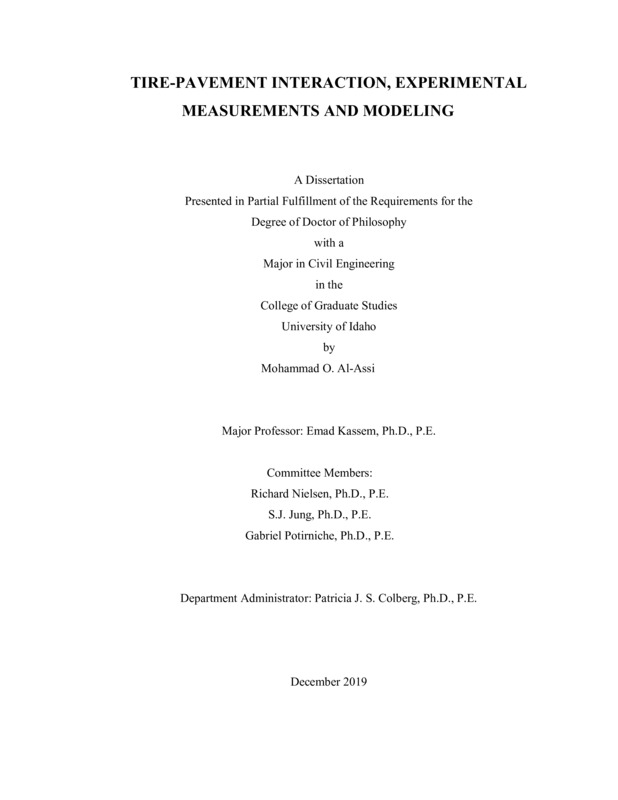TIRE-PAVEMENT INTERACTION, EXPERIMENTAL MEASUREMENTS AND MODELING
Al-Assi, Mohammad Omar. (2019-08). TIRE-PAVEMENT INTERACTION, EXPERIMENTAL MEASUREMENTS AND MODELING. Theses and Dissertations Collection, University of Idaho Library Digital Collections. https://www.lib.uidaho.edu/digital/etd/items/alassi_idaho_0089e_11685.html
- Title:
- TIRE-PAVEMENT INTERACTION, EXPERIMENTAL MEASUREMENTS AND MODELING
- Author:
- Al-Assi, Mohammad Omar
- ORCID:
- 0000-0003-1871-3757
- Date:
- 2019-08
- Embargo Remove Date:
- 2022-06-25
- Keywords:
- CRP DFT Finite Element Macrotexture Microtexture Skid Resistance
- Program:
- Civil Engineering
- Subject Category:
- Transportation
- Abstract:
-
Providing an adequate level of skid resistance is essential for the safety of motorists. Previous studies demonstrated that the number of crashes is reduced if pavements have sufficient friction, especially in wet conditions. Adequate pavement friction prevents the vehicle from sliding on the pavement surface and provides the grip needed to maintain control over the vehicle. The first phase of this study investigated experimentally the two major friction mechanisms (i.e., adhesion and hysteresis) that contribute to tire-pavement friction. It is postulated that the adhesion between rubber tires and pavements is highly influenced by the surface free energy. However, there are no previous studies carried out to investigate the adhesion between rubber tires and pavements using the surface free energy. The results demonstrated that adhesion friction can be quantified by measuring the surface free energy components of pavement surface aggregates and rubber materials. There was a fair correlation between the adhesive bond energy and the measured coefficient of friction. Higher adhesion between rubber materials and pavement surface provided higher friction. These results provide a fundamental understanding of the mechanisms of rubber-pavement friction and verification of the relationship between adhesion and friction. In addition, there was a strong correlation between friction and rubber rheological properties. Rubber materials with lower modulus provided higher friction compared to those with higher modulus. These results explain the change in skid resistance with temperature throughout the year.
The second phase of this study examined different factors that affect skid resistance of pavement surfaces. These parameters included macrotexture, microtexture, and driving speed. The macrotexture of the pavement is related to aggregate gradation of the mix or surface texture pattern. The microtexture is influenced by the roughness of the aggregate particles and their resistance to abrasion and polishing under traffic. This study proposed a new model that can be used to estimate the skid number at a given speed between 20 mph and 60 mph as a function of both macrotexture and microtexture of pavement surface. This model was developed based on the measured frictional characteristics of field test sections. The proposed model can be used if the full-scale friction tester is not available or cannot be used due to the limited length of the test section (e.g., bridge deck). In addition, the model provides a tool to the pavement engineers to ensure adequate skid resistance at various operation speeds during the mix design stage and before the mix is used in the field. A given mix design can be modified to improve its frictional characteristics at early stage which leads to cost savings often spent on the application of surface treatments.
The third phase of this study utilized the close-range photogrammetry (CRP) technique to measure the pavement macrotexture and microtexture. Texture parameters were calculated from the collected and analyzed images of the pavement surface. The results of the CRP texture measurements were compared to standard test methods. The CRP texture measurements had excellent correlation with the standard methods; however, the CRP offers simple and accurate, yet inexpensive alternative to the current methods used to measure surface macrotexture and microtexture. In addition, the CRP texture parameters were incorporated in the Persson friction model to predict skid friction as a function of rubber properties. The results demonstrated excellent correlation between measured and predicted friction. This study greatly simplified the texture parameter calculations needed in the Persson friction model with good accuracy.
The last component of this study developed a 3D finite element model to investigate the effect of surface characteristics along with rubber properties on the contact stress between the standard skid test tire and pavement surface. Such simulation provides an in-depth understanding of tire-pavement interaction that would require expensive resources to examine in the field. Study parameters included various coefficient of friction, texture (e.g., smooth, and grooved), tire rolling conditions (fully skidding and free rolling) as well as temperature. The developed 3D FE model of the test tire was first validated with laboratory measurements before it was used to examine the effect of the study parameters on tire-pavement contact stresses. The results of the finite element simulations demonstrated that the stress distribution at the tire-pavement interface is non-uniform with maximum values towards the edges of the tire. These findings were consistent with the wearing pattern of the test tire in the field. In addition, the results also demonstrated that the shear stresses increased with surface friction while there was no significant change in the vertical stresses. The grooved surface exhibited higher vertical and shear stresses compared to pavement with smooth texture. The grooved texture is used to improve skid resistance and reduce the noise of pavement surfaces. In addition, temperature was found to have significant impact on the stresses at the tire-pavement interface. The finite element simulation results agreed with the laboratory and field measurements of pavement friction.
- Description:
- doctoral, Ph.D., Civil Engineering -- University of Idaho - College of Graduate Studies, 2019-08
- Major Professor:
- Kassem, Emad
- Committee:
- Nielsen, Richard; Jung, S.J.; Potirniche, Gabriel
- Defense Date:
- 2019-08
- Identifier:
- AlAssi_idaho_0089E_11685
- Type:
- Text
- Format Original:
- Format:
- application/pdf
- Rights:
- In Copyright - Educational Use Permitted. For more information, please contact University of Idaho Library Special Collections and Archives Department at libspec@uidaho.edu.
- Standardized Rights:
- http://rightsstatements.org/vocab/InC-EDU/1.0/

